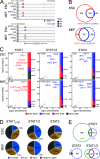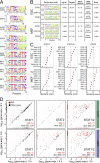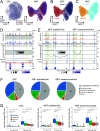Epigenetic signals that direct cell type-specific interferon beta response in mouse cells
- PMID: 36732019
- PMCID: PMC9900254
- DOI: 10.26508/lsa.202201823
Epigenetic signals that direct cell type-specific interferon beta response in mouse cells
Abstract
The antiviral response induced by type I interferon (IFN) via the JAK-STAT signaling cascade activates hundreds of IFN-stimulated genes (ISGs) across human and mouse tissues but varies between cell types. However, the links between the underlying epigenetic features and the ISG profile are not well understood. We mapped ISGs, binding sites of the STAT1 and STAT2 transcription factors, chromatin accessibility, and histone H3 lysine modification by acetylation (ac) and mono-/tri-methylation (me1, me3) in mouse embryonic stem cells and fibroblasts before and after IFNβ treatment. A large fraction of ISGs and STAT-binding sites was cell type specific with promoter binding of a STAT1/2 complex being a key driver of ISGs. Furthermore, STAT1/2 binding to putative enhancers induced ISGs as inferred from a chromatin co-accessibility analysis. STAT1/2 binding was dependent on the chromatin context and positively correlated with preexisting H3K4me1 and H3K27ac marks in an open chromatin state, whereas the presence of H3K27me3 had an inhibitory effect. Thus, chromatin features present before stimulation represent an additional regulatory layer for the cell type-specific antiviral response.
© 2023 Muckenhuber et al.
Conflict of interest statement
The authors declare that they have no conflict of interest.
Figures












References
Publication types
MeSH terms
Substances
LinkOut - more resources
Full Text Sources
Molecular Biology Databases
Research Materials
Miscellaneous
